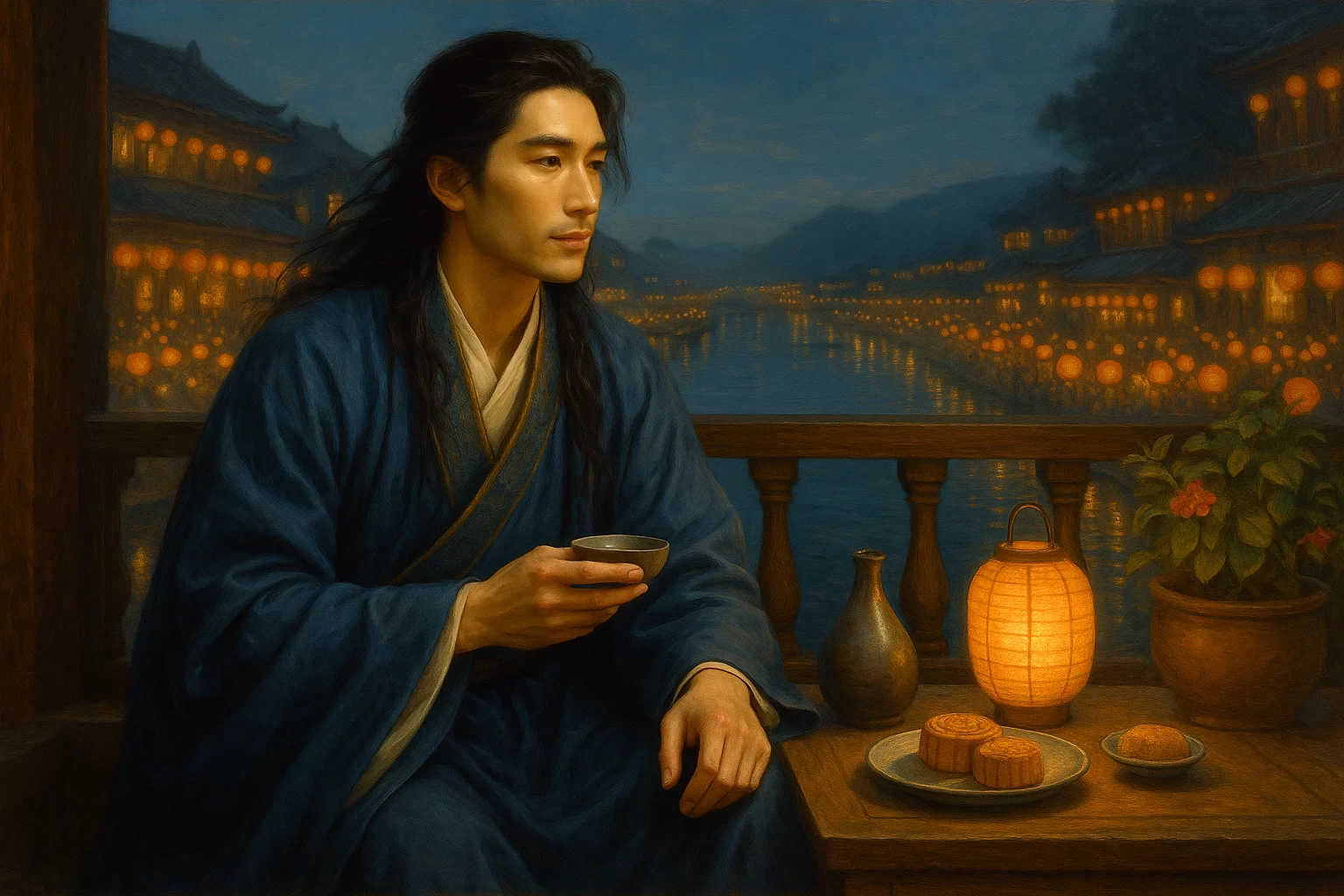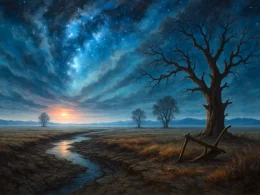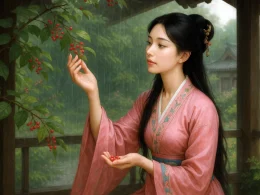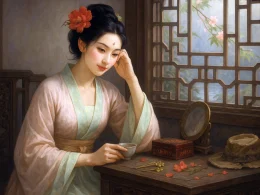Land of grace! Who counts Southern Dynasties' gold?
Mountains coil round old glory, rivers fold.
Furious tides beat lone walls—dumb, bleak,
Wind-wings dissolve where sky and water speak.
Cliff-hung trees still root upside,
Mo Chou's boat-ropes long untied.
Only moss-clad ruins breathe,
Fog swallows half-forts beneath.
Moonlight tiptoes past midnight battlements,
Weeping east where Huai's dark current bends.
Where's the wine-shops' clamor, theater's cry?
Maybe where Wang-Xie's mansions scrape the sky.
Swallows—blind to time's decay—
Dart through hut-lanes today,
Chirping tales of fallen kings,
While dying sunlight stings.
Original Poem
「西河 · 金陵怀古」
佳丽地,南朝盛事谁记?
山围故国绕清江,髻鬟对起。
怒涛寂寞打孤城,风樯遥度天际。断崖树、犹倒倚,莫愁艇子曾系。
空余旧迹郁苍苍,雾沉半垒。
夜深月过女墙来,伤心东望淮水。酒旗戏鼓甚处市?
周邦彦
想依稀、王谢邻里。
燕子不知何世,入寻常、巷陌人家,
相对如说兴亡,斜阳里。
Interpretation
Composed during the Xuanhe era (1119-1125) of Emperor Huizong's reign, this ci emerges from the Northern Song Dynasty's twilight years—a time of peasant uprisings in the south and Jurchen invasions in the north. While on official travel through Jinling (modern Nanjing), Zhou Bangyan ascended its historic heights to survey Southern Dynasties remnants. Amidst collapsing empire and personal displacement, he channeled unprecedented political urgency into this work, blending majestic landscape depiction with elegiac historiography to create his most monumental meditation on dynastic decay.
First Stanza: "佳丽地,南朝盛事谁记?山围故国绕清江,髻鬟对起。怒涛寂寞打孤城,风樯遥度天际。"
Jiā lì dì, nán cháo shèng shì shuí jì? Shān wéi gù guó rào qīng jiāng, jì huán duì qǐ. Nù tāo jì mò dǎ gū chéng, fēng qiáng yáo dù tiān jì.
This land of splendor—
who recalls Southern Dynasties' glory?
Mountains encircle ancient capitals,
clear rivers coil—
peaks rise like paired coiffures.
Angry tides pound lonely walls,
sail-dots vanish beyond heaven's rim.
The stanza opens with cartographic grandeur, framing Jinling's geography through dynastic memory. "Peaks rise like paired coiffures" (髻鬟对起) anthropomorphizes topography as courtly beauties, contrasting nature's enduring elegance with human regimes' fragility. The "angry tides" (怒涛) personify historical forces eroding the "lonely walls" (孤城) of power, while distant "sail-dots" (风樯) symbolize both literal departures and the retreat of historical consciousness. Zhou's landscape becomes a seismograph recording civilization's tremors.
Second Stanza: "断崖树、犹倒倚,莫愁艇子曾系。空余旧迹郁苍苍,雾沉半垒。夜深月过女墙来,伤心东望淮水。"
Duàn yá shù, yóu dào yǐ, Mòchóu tǐng zǐ céng xì. Kōng yú jiù jī yù cāng cāng, wù chén bàn lěi. Yè shēn yuè guò nǚ qiáng lái, shāng xīn dōng wàng Huái shuǐ.
Cliff-clinging trees still lean askew—
where Mo Chou once moored her boat.
Only moss-choked traces remain,
mists drown half-fallen battlements.
Midnight moon climbs the parapet,
my grieving gaze follows Huai River east.
Transitioning to archaeological close-up, Zhou examines cultural fragments. The "cliff-clinging trees" (断崖树) become living ruins, their twisted forms embodying historical distortion. "Mo Chou's boat" (莫愁艇子) invokes the legendary figure—a poetic vessel connecting present decay to mythic past. The "moon climbing parapets" (月过女墙) casts celestial judgment on ruined defenses, while the Huai River's eastward flow mirrors time's irreversible current. These images construct a palimpsest where nature slowly reclaims human endeavors.
Third Stanza: "酒旗戏鼓甚处市?想依稀、王谢邻里。燕子不知何世,入寻常、巷陌人家,相对如说兴亡,斜阳里。"
Jiǔ qí xì gǔ shèn chù shì? Xiǎng yīxī, Wáng Xiè lín lǐ. Yànzi bù zhī hé shì, rù xúncháng, xiàng mò rén jiā, xiāngduì rú shuō xīng wáng, xié yáng lǐ.
Where now the tavern signs,
the theater drums?
Faintly I trace Wang-Xie mansions…
Swallows—ignorant of eras—
dart through common alleys,
chattering of rise and fall
in slanting sunlight.
The finale dissolves temporal boundaries. The vanished "tavern signs" (酒旗) and "theater drums" (戏鼓) symbolize extinct cultural vitality, while "Wang-Xie mansions" (王谢邻里)—referencing Eastern Jin's most powerful clans—measure historical amnesia's depth. The swallows' ahistorical nesting (燕子不知何世) indicts human historicity, their innocent "chattering" (相对如说) becoming ironic commentary on dynastic cycles. The "slanting sunlight" (斜阳里) casts the entire scene in elegiac glow, nature's indifference underscoring human transience.
Holistic Appreciation
This ci orchestrates a symphony of spatial and temporal scales. The first stanza's panoramic geography ("mountains encircle," "rivers coil") establishes Jinling as cosmic theater. The second zooms to architectural relics ("half-fallen battlements"), then to botanical witnesses ("cliff-clinging trees"). The finale dissolves into avian microhistory—swallows whose nest-building transcends human chronology.
Zhou's structural genius lies in counterpointing vertical and horizontal dimensions: the "paired coiffures" of mountains versus the Huai River's linear flow; the moon's ascent against the swallows' lateral darting. This multidimensionality mirrors Chinese historiography's dual focus—cyclical dynasties versus linear time—making the poem both a landscape and a temporal diagram.
Artistic Merits
- Geological historiography
Mountains and rivers become archival strata recording dynastic rise and fall. - Archaeological optics
The poet's gaze operates like a scholar's loupe, examining cultural fragments ("moss-choked traces") with forensic precision. - Avian irony
Swallows function as unwitting historians, their "chattering" an unconscious chorus to human tragedy. - Luminist temporality
The "slanting sunlight" and "midnight moon" frame history as diurnal cycle, where empires wax and wane like celestial bodies.
Insights
Zhou's poem articulates a devastating truth: that nature outlasts nations, and swallows inherit palaces. His Jinling is no longer just a city but a metaphysical lesson—where "angry tides" of time reduce human ambition to "moss-choked traces."
For contemporary audiences, the work offers urgent metaphors. The "half-fallen battlements" resonate with modern ruins—from abandoned factories to digital ghost towns—while the swallows' ahistorical nesting mirrors our own species' ecological amnesia. Zhou ultimately suggests that true historical consciousness requires recognizing our own eventual status as "moss-choked traces."
The poem's deepest insight lies in its avian punchline: that civilization's most profound chroniclers may be creatures who don't read histories. When the last scholar forgets the Wang-Xie clans, the swallows will still chatter in slanting light—a reminder that all human grandeur is but temporary substrate for life's enduring cycles.
About the Poet

Zhou Bangyan (周邦彦 1056 - 1121), a native of Qiantang (modern Hangzhou, Zhejiang), was the culminating master of the wanyue (graceful and restrained) ci poetry of the Northern Song Dynasty. A virtuoso in musical temperament, his ci are renowned for their opulent refinement and technical perfection. He created dozens of new melodic patterns (cipai) and adhered to strict tonal rules, earning him the title "Crown of Ci Poets." His influence extended to Southern Song masters like Jiang Kui and Wu Wenying, establishing him as the founding patriarch of the Rhymed Ci School.












